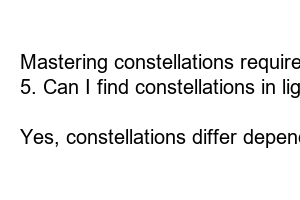별자리 찾는법
Title: Discover the Celestial Beauty: How to Find Constellations
Introduction:
Gazing upon the night sky filled with countless twinkling stars has fascinated humanity for centuries. One of the mesmerizing aspects of stargazing is identifying constellations. In this blog post, we will explore simple steps to help you uncover the wonders of the night sky and find constellations with confidence.
1. Embrace the Darkness:
To have a better chance of spotting constellations, venture away from city lights and find a location with minimal light pollution. A secluded park, a beach, or even your backyard will suffice. Remember, the darker the sky, the clearer the constellations will appear.
2. Familiarize Yourself with the Star Patterns:
Each constellation comprises a unique pattern of stars that, when seen together, forms a specific shape. To get started, choose a few well-known constellations such as Orion, Ursa Major, or Cassiopeia. Study their patterns by referring to star charts or using astronomy apps, enabling you to identify them more easily.
3. Utilize Stellar Landmarks:
Once you’ve become familiar with basic constellations, locate bright stars or planets that can serve as reference points. These “anchors” will guide you in connecting nearby stars and determining the shape of a constellation. For instance, you can use the bright star Sirius in Canis Major as a starting point for identifying the constellation.
4. Connect the Dots:
Now comes the fun part! Once you spot the initial reference point, mentally connect the neighboring stars, creating the outline of a constellation. Try not to limit yourself to individual stars; instead, envision lines connecting them and forming a recognizable shape. Drawing imaginary lines can enhance your chances of accurately identifying constellations.
5. Use Astronomical Tools:
To assist your stargazing adventure, consider using binoculars or a small telescope. These tools can unveil details that may be difficult to discern with the naked eye, allowing you to see dimmer stars and smaller constellations more clearly. This can enhance your overall experience of navigating the night sky.
6. Patience and Perseverance:
Remember, learning to identify constellations takes time and practice. Be patient with yourself and enjoy the journey. The more you observe the night sky, the better your understanding of constellations will become.
Summary:
Embark on a captivating stargazing expedition by learning how to find constellations. Begin by embracing the darkness and moving away from light pollution. Familiarize yourself with star patterns, use bright stars as references, connect the dots to form constellations, and incorporate astronomical tools for a closer look. Finally, do not forget to exercise patience and perseverance as your journey in discovering the celestial wonders unfolds.
FAQs:
1. Are all constellations visible throughout the year?
While some constellations are visible year-round, others are seasonal. The changing position of the Earth in its orbit causes different constellations to appear at different times.
2. Can I find constellations without any equipment?
Absolutely! Many constellations can be seen with the naked eye. However, binoculars or a telescope can enhance your experience and allow you to explore fainter stars and smaller constellations.
3. Is it necessary to learn the names of all constellations?
No, it is not necessary. Start by focusing on a few well-known constellations, and as you gain confidence and experience, you can expand your knowledge.
4. How long does it take to identify constellations?
Mastering constellations requires practice and patience. With regular stargazing sessions, you will gradually improve your ability to spot and identify them.
5. Can I find constellations in light-polluted areas?
While it might be more challenging to see constellations in areas with high light pollution, it is still possible to identify the brightest and most prominent ones.
6. Can I find constellations in different hemispheres?
Yes, constellations differ depending on the hemisphere you are in. The Southern Hemisphere has its own distinct constellations, such as the Southern Cross and the Magellanic Clouds.

